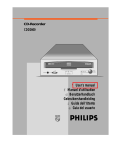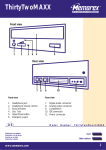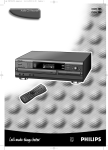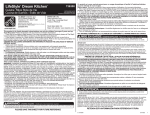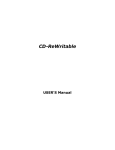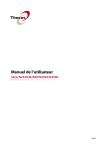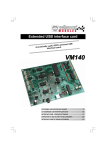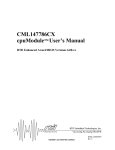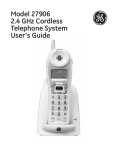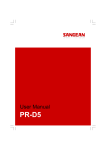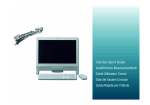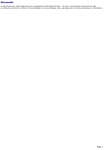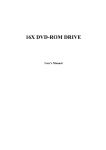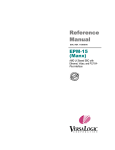Download English
Transcript
01_LAYOUT_GB 22-11-2000 09:21 Pagina 1a Recordable ReWritable OPEN/CLOSE PHONES VOLUME WRITING DISC IN ACTIVE 01_LAYOUT_GB 22-11-2000 09:21 Pagina 1b CDRW 8x4x32 - Compact Disc Recordable/Rewritable FIG.1 Front view Recordable ReWritable OPEN/CLOSE PHONES DISC IN WRITING VOLUME ACTIVE Rear view MASTER MASTER SLAVE SLAVE CABLE CABLE SELECT SELECT AUDIO AUDIO OUT OUT R R GND GND LL IDE IDE PIN PIN 11 C CS SM M S S LL A A +5 +5 DC DC INPUT INPUT GND GND +12 +12 12 Front view © Vorderansicht d Panneau avant 1. 2. 3. 4. 5. Headphone plug Headphone volume control Write indicator Disc Tray Disc in/Active/error indicator 6. Open/Close button 7. Emergency eject 1. 2. 3. 4. 5. Anschlußbuchse Kopfhörer Lautstärke Kopfhörer Schreibanzeige Schublade Diskette ein/Aktiv/Fehler anzeige 6. Open/Close Taste 7. Notauswurf 1. Prise pour casque 2. Commande du volume du casque 3. Témoin lumineux d’enregistrement 4. Tiroir à disque 5. Témoin disque/Activé/erreur 6. Touche ouvrir/fermer 7. Ejection d’urgence Rear view Rückansicht Panneau arriëre 8. Audio Line Out connector 9. Jumperblock 10. IDE connector 11. Host DC power connector 12. Digital Audio out 8. 9. 10. 11. Analog Audio-Ausgang Jumperblock IDE Anschluß Host Gleichspannungsanschluß 12. Digital Audio-Ausgang 8. Connecteur de sortie de ligne audio 9. Cavaliers 10. Connecteur IDE 11. Connecteurs au bloc d’alimentation C.C. hôte 12. Sortie audio numérique Parte anteriore Vista frontal Voorzijde i e 1. 2. 3. 4. 5. Presa cuffie Controllo volume cuffie Indicatore di scriture Cassetto del disco Indicatore disco inserito/Attivo/Errore 6. Tasto Apertura/Chiusura 7. Espulsione di emergenza 1. Clavija de los auriculares 2. Control del volumen de los auriculares C.D. 3. Indicador escritura 4. Bandeja del Disco 5. Indicador de Disco introducido/Activo/Error 6. Bóton de Apertura/Cierre 7. Expulsión de emergencia 1. 2. 3. 4. 5. Parte posteriore Vista posterior Achterzijde 8. 9. 10. 11. 12. 8. Conector de salida de Línea de Audio 9. Bloque de conectores 10. Conector IDE 11. Conector de alimentacíon 12. Salida de audio digital 8. 9. 10. 11. Connettore Line Out Audio Blocco Jumpers Connettore IDE Connettore alimentazione DC Uscita audio digitale f ñ Hoofdtelefoon aansluiting Hoofdtelefoon volumeregelaar Schrijfindicator Disc-lade Disc aanwezig/ Actief/foutindicator 6. Openen/sluiten-toets 7. Nood-eject Audio-connector lijnuitgang Jumper-block IDE connector Voedingsconnector host computer 12. Digital audio-uitgang 01_LAYOUT_GB 22-11-2000 09:21 Pagina 1c 01_LAYOUT_GB 22-11-2000 09:21 Pagina 1d WARNING This device complies with Part 15 of the FCC (U.S.A.) Rules. Operation is subject to the following two conditions: (1) This device may not cause harmful interference, and (2) this device must accept any interference received, including interference that may cause undesired operation. NOTE This equipment has been tested and found to comply with the limits for a Class B digital device, pursuant to Part 15 of the FCC Rules. These limits are designed to provide reasonable protection against harmful interference in a residential installation. This equipment generates, uses and can be used in accordance with the instructions, may cause harmful interference to radio communications. However, there is no guarantee that interference will not occur in a particular installation. If this equipment does cause harmful interference to radio or television reception, which can be determined by turning this equipment off and on, the user is encouraged to try to correct the interference by one or more of the following measures: • Reorient or relocate the receiving antenna. • Increase the separation between the equipment and receiver. • Connect the equipment into an outlet on a circuit different from that to which the receiver is connected. • Consult the dealer or an experienced radio/TV technician for help. FOR CANADA (ICES-003) This class B digital apparatus meets all requirements of the Canadian Interference-Causing Equipment Regulations. Cet appareil numerique de la classe B respecte toutes les exigences du Reglement sur le materiel brouilleur de Canada. FOR EUROPE “The CDRW 8x4x32 is in conformity with the EMC directive and low-voltage directive IMPORTANT Any change or modifications to the equipment by the user not expressly approved by the grantee or manufacturer could void the user's authority to operate such equipment. 01_LAYOUT_GB 22-11-2000 09:21 CDRW Pagina 1e CONTENTS ENGLISH © INTRODUCTION . . . . . . . . . . . . . . . . . . . . . . . . . . . . . . . . . . . . . . . . . . . . . . . . . . . . . . . . . . . . . . . . . .1 INSTALLATION . . . . . . . . . . . . . . . . . . . . . . . . . . . . . . . . . . . . . . . . . . . . . . . . . . . . . . . . . . . . . . . . . . .3 SUMMARY OF CONTROLS AND CONNECTIONS . . . . . . . . . . . . . . . . . . . . . . . . . . . . . . . . . . . . . . .9 OPERATING/TESTING YOUR CD-RECORDABLE/REWRITABLE SYSTEM . . . . . . . . . . . . . . . . . . . . . .11 ADDITIONAL INFORMATION . . . . . . . . . . . . . . . . . . . . . . . . . . . . . . . . . . . . . . . . . . . . . . . . . . . . . . . .13 APPENDIX . . . . . . . . . . . . . . . . . . . . . . . . . . . . . . . . . . . . . . . . . . . . . . . . . . . . . . . . . . . . . . . . . . .18 NOTES . . . . . . . . . . . . . . . . . . . . . . . . . . . . . . . . . . . . . . . . . . . . . . . . . . . . . . . . . . . . . . . . . . .30 DEUTSCH d EINLEITUNG .................................................. INSTALLATION . . . . . . . . . . . . . . . . . . . . . . . . . . . . . . . . . . . . . . . . . . . . . . . . . . BEDIENELEMENTE UND ANSCHLÜSSE . . . . . . . . . . . . . . . . . . . . . . . . . . . . . . . . BEDIENUNG UND PRÜFUNG DES CD-RECORDABLE/REWRITABLE-SYSTEMS ZUSÄTSLICHE INFORMATIONEN . . . . . . . . . . . . . . . . . . . . . . . . . . . . . . . . . . . . HINWEISE .................................................. . . . . . . . . . . . . . . . . . . . . . . . . . . . . . . . . . . . . . . . . . . . . . . . . . . . . . . . . . . . . . . . . . . . . . . . . . . . . . . . . . . . . . . . . . . . . . . . . .31 .33 .39 .41 .43 .44 INTRODUCTION . . . . . . . . . . . . . . . . . . . . . . . . . . . . . . . . . . . . . . . . . . . . . . . . . . . . . . . INSTALLATION . . . . . . . . . . . . . . . . . . . . . . . . . . . . . . . . . . . . . . . . . . . . . . . . . . . . . . . . RÉSUMÉ DES COMMANDES ET CONNEXIONS . . . . . . . . . . . . . . . . . . . . . . . . . . . . . . . UTILISEZ/TESTEZ VOTRE SYSTÈME POUR CD ENREGISTRABLE/RÉENREGISTRABLES INFORMATIONS COMPLÉMENTAIRES . . . . . . . . . . . . . . . . . . . . . . . . . . . . . . . . . . . . . . REMARQUES ........................................................ . . . . . . . . . . . . . . . . . . . . . . . . . . . . . . . . . . . . . . . . . . . . . . . . . . . . . . . . . . . . .45 .47 .53 .55 .57 .58 INTRODUZIONE . . . . . . . . . . . . . . . . . . . . . . . . . . . . . . . . . . . . . . . . . . . . . . . . . . . . . . . INSTALLAZIONE . . . . . . . . . . . . . . . . . . . . . . . . . . . . . . . . . . . . . . . . . . . . . . . . . . . . . . . . SOMMARIO DEI COMANDI E DEI COLLEGAMENTI . . . . . . . . . . . . . . . . . . . . . . . . . . . USO/VERIFICA DEL FUNZIONAMENTO DEL SISTEMA REGISTRATORE/REWRITABLE ALTRE INFORMAZIONI . . . . . . . . . . . . . . . . . . . . . . . . . . . . . . . . . . . . . . . . . . . . . . . . . . NOTE ........................................................ . . . . . . . . . . . . . . . . . . . . . . . . . . . . . . . . . . . . . . . . . . . . . . . . . . . . . . . . . . . . .59 .61 .67 .69 .71 .72 INTRODUCCIÓN . . . . . . . . . . . . . . . . . . . . . . . . . . . . . . . . . . . . . . . . . . . . . . . . . INSTALACIÓN . . . . . . . . . . . . . . . . . . . . . . . . . . . . . . . . . . . . . . . . . . . . . . . . . . RESUMEN DE CONTROLES Y CONECTORES . . . . . . . . . . . . . . . . . . . . . . . . . . FUNCIONAMIENTO/PRUEBA DEL SISTEMA DE CD-GRABABLE/REESCRIBIBLE INFORMACIÓN ADICIONAL . . . . . . . . . . . . . . . . . . . . . . . . . . . . . . . . . . . . . . . . OBSERVACÍONES . . . . . . . . . . . . . . . . . . . . . . . . . . . . . . . . . . . . . . . . . . . . . . . . . . . . . . . . . . . . . . . . . . . . . . . . . . . . . . . . . . . . . . . . . . . . . . . . . . . . . . . . . . . . . .73 .75 .81 .83 .85 .86 FRANÇAIS f ITALIANO i ESPAÑOL e . . . . . . . . . . . . . . . . . . . . . . . . . . . . . . . . . . . . NEDERLANDS ñ INLEIDING . . . . . . . . . . . . . . . . . . . . . . . . . . . . . . . . . . . . . . . . . . . . . . . . . . . . . . . . . . . . . . . . . . .87 INSTALLEREN . . . . . . . . . . . . . . . . . . . . . . . . . . . . . . . . . . . . . . . . . . . . . . . . . . . . . . . . . . . . . . . . . . .89 BEDIENINGSOVERZICHT EN AANSLUITINGEN . . . . . . . . . . . . . . . . . . . . . . . . . . . . . . . . . . . . . . . . .95 BEDIENEN/TESTEN VAN UW CD-RECORDABLE/REWRITABLE-DRIVE . . . . . . . . . . . . . . . . . . . . . . .97 EXTRA INFORMATIE . . . . . . . . . . . . . . . . . . . . . . . . . . . . . . . . . . . . . . . . . . . . . . . . . . . . . . . . . . . . . . .99 OPMERKINGEN . . . . . . . . . . . . . . . . . . . . . . . . . . . . . . . . . . . . . . . . . . . . . . . . . . . . . . . . . . . . . . . . . . .100 01_LAYOUT_GB 22-11-2000 09:21 Pagina 1f LASER SAFETY This unit employs a laser. Do not remove the cover or attempt to service this device when connected due to the possibility of eye damage. LASER-SICHERHEIT In das Gerät ist ein Laser eingebaut. Nehmen Sie die Abdeckung nicht ab und versuchen Sie nicht, das Gerät zu reparieren, solange es angeschlossen ist. Es besteht die Gefahr einer Augenverletzung. CAUTION USE OF CONTROLS OR ADJUSTMENTS OR PERFORMANCE OF PROCEDURES OTHER THAN THOSE SPECIFIED HEREIN MAY RESULT IN HAZARDOUS LASER RADIATION EXPOSURE. WARNUNG DIE VORNAHME VON REGELUNGEN ODER EINSTELLUNGEN ODER DIE DURCHFÜHRUNG VON VERFAHREN, DIE NICHT IN DIESEM DOKUMENT (DIESER BESCHREIBUNG; IM NACHSTEHENDEN TEXT) ANGEGEBEN SIND, KANN EINE GEFÄHRLICHE EINWIRKUNG VON LASERSTRAHLUNG ZUR FOLGE HABEN. CLASS 1 LASER PRODUCT LUOKAN I LASERLAITE KLASS 1 LASERAPPARAT KLASSE 1 LASER-PRODUKT CAUTION INVISIBLE BEAM LASER RADIATION WHEN VARO! AVATTAESSA OLET ALTIINA ÄLÄ KATSO SÄTEESEN NÄKYMÄTTÖMÄLLE VARNING OSYNLIG LASERSTRÅLNING BETRAKTA EJ STRÅLEN NÄR ADVERSEL USYNLIG LASERSTRÅLING VED ÅBNING. UNDGÅ UNSAETTELSE FOR STRÅLING DANGER INVISIBLE LASER EXPOSURE TO BEAM VORSICHT INSICHTBARE LASERSTRAHLUNG NICHT DEM STRAHL AUSSETSEN RADIATION OPEN AVOID DENNA EXPOSURE LASER DEL OPEN WENN ABDECKUNG LASER Type Semiconductor laser GaAlAs Wavelength 780~800 nm (at 25° C) Output Power (measured above the objective lens) 1 mW (Read) 30 mW (Write) Beam divergence 60 degree. SÄTTEILYLLE ÄR WHEN TO AVOID ÖPPNAD DIRECT GEÖFFNET 01_LAYOUT_GB 22-11-2000 09:21 CDRW Pagina 1 INTRODUCTION ENGLISH INTRODUCTION CDRW 8x4x32 is a new generation Half Height 5.25" Built-in CDRecordable/ReWritable drive with the popular (Enhanced) IDE interface. The drive is in fact a multi-function device, since it can be used as: • fast CD-ROM reader (max 32x) • 8x speed CD-Recorder, e.g. to record your own CD-ROM's or Audio-CD's • 4x speed CD-ReWritable device to use as your personal storage medium, by using Incremental Packet Writing The CDRW 8x4x32 is the ideal tool for publishing large amounts of data in compact form on CD. The Incremental Packet Writing function will make this drive attractive to the general desktop PCuser for personal data storage. CD-Recordable discs can be recorded at 8x speed, and in all standard formats, e.g. CD-Audio, CD-ROM (XA), CD-i and VideoCD among others. Since these discs are recorded in accordance with the Orange Book (part II) specification, these discs can be played back on all compatible CD-players. CD-ReWritable is a feature which allows re-use of previously written discs by rewriting portions or the complete disc in accordance with the Orange Book (partIII) specification. These discs can be recorded at quadruple speed in all standard formats. 1 01_LAYOUT_GB 22-11-2000 09:21 CDRW Pagina 2 INTRODUCTION (CONT.) ENGLISH Features of the CDRW 8x4x32 CD-Recordable/ReWritable drive: • Multi-function device (CD-ROM reader, CD-Recorder and CD-ReWritable drive) • Supports Incremental Packet Writing for data storage applications and "drag & drop" File System support through the CD-UDF standard (endorsed by Optical Storage Technology Association or OSTA) • Supports standardised Multi Media Commandset (MMC-2) as standardised by the American National Standards Institute (ANSI) • Plug & Play read compatibility under Windows 95/98/2000 and Windows NT • Interfaces directly to low cost standardised (Enhanced) IDE connector on PC motherboard • Supports Fast Format (Background Formatting) depending on the application software, which reduces formatting time of a CD-RW disc to only a few minutes. Unpacking If the CDRW 8x4x32 package shows evidence of rough handling or damage and the drive does not function properly on initial startup: return the drive and damaged package to your supplier and request a replacement. Lift out the CDRW 8x4x32 and remove the packing pieces. Check that the package contains following items : • User manual • Mounting screws An IDE flatcable and/or audio cable could be part of this package depending on the commerical package. It can also be obtained from your local supplier. 2 01_LAYOUT_GB 22-11-2000 09:21 CDRW Pagina 3 INSTALLATION ENGLISH INSTALLATION Precautions This CD-Recordable/Rewritable drive, like all electronic equipment, is static sensitive. • Please take the proper precautions when handling the drive, for example by touching the PC - chassis before touching the drive. • Avoid touching the IDE connector pins as well as the audioconnector pins and the jumper pins. • Keep the drive in its conductive wrapping until you are ready to install the drive in your computer. Safety Precautions • Europe: This drive shall be installed only with an EN60950 (IEC950) approved Power supply. • USA/Canada: This drive is for use only with IBM compatible UL listed Personal Computers or Macintosh UL listed workstations weighing less than 18 kg. Copyright Statement It is a criminal offence, under applicable copyright laws, to make unauthorised copies of copyright-protected material, including computer programs, films, broadcasts and sound recordings. This equipment should not be used for such purposes. 3 01_LAYOUT_GB 22-11-2000 09:21 CDRW Pagina 4 INSTALLATION (CONT.) ENGLISH Installing the drive 1 Turn off your computer, monitor and other peripherals. To disconnect your configuration completely from the mains, the mains plug has to be disconnected. NOTE: OPEN THE COVER FLAP OF THIS BOOKLET FOR LOCATING THE DRIVE-CONNECTORS AND THEIR ORIENTATION. 2 Remove the cover from your computer. Please consult the manuals that came with your computer for specific details. 4 01_LAYOUT_GB 22-11-2000 09:21 Pagina 5 INSTALLATION CDRW (CONT.) ENGLISH 3 In order to mount the drive inside your PC (or other type of computer), locate a free 5.25" bay and follow the instructions, as provided with your computer systems, for installing the drive. When you are planning to use 8 cm discs your drive should be mounted horizontaly or you should use an adapter (for information contact your local supplier). 4 You have several possibilities to install your IDE data cable depending on your existing configuration: (See page 18 for Jumper block) A) Hard-Disc connected as Master to Primary IDE Port, CD-ROM connected as Master to Secundary IDE Port: Connect CDRW 8x4x32 as Slave to Secundary IDE Port. Jumper Block PC Configuration after Installation Existing PC Configuration C S M S MASTER MASTER SLAVE Primary Port Hard-Disc - Primary Port Hard-Disc Secundary Port CD-ROM - Secundary Port CD-ROM 5 SLAVE CDRW 8x4x32 01_LAYOUT_GB 22-11-2000 09:21 CDRW Pagina 6 INSTALLATION (CONT.) ENGLISH B) Single Hard-disc connected as master to Primary IDE Port: Connect CDRW 8x4x32 as Master to Secundary Port. Jumper Block PC Configuration after Installation Existing PC Configuration C S M S Primary Port Hard-Disc Secundary Port C) - - Primary Port Hard-Disc - Secundary Port CDRW 8x4x32 - Hard-disc connected as Master to Primary IDE Port, CD-ROM connected as Slave to Primary IDE Port: Connect CDRW 8x4x32 as Master to Secundary IDE Port. Jumper Block PC Configuration after Installation Existing PC Configuration Primary Port MASTER SLAVE Hard-Disc CD-ROM Secundary Port - C S M S - MASTER SLAVE Primary Port Hard-Disc CD-ROM Secundary Port CDRW 8x4x32 - D) CS (Cable Select) (With use of CS Cable) The MASTER/SLAVE settting will be set automatically depending on the hardware configuration. Please refer to your PC manual for details. NOTE: INSTALLATION A IS PREFERRED IDE HARD-DISC AND CD-ROM. FOR SYSTEMS WITH AN NOTE: INSTALLATION B IS IDE HARD-DISC. ONLY AN 6 PREFERRED FOR SYSTEMS WITH 01_LAYOUT_GB 22-11-2000 09:21 Pagina 7 INSTALLATION CDRW (CONT.) ENGLISH 5 Locate the free end of the IDE data cable and thread it out through the open drive bay. Do the same with the power cable and the (optional) audio cable (digital or analogue). Your system will either be equipped with an analogue or digital soundcard connector. Use the appropriate connector on the drive recognisable with the amount of pins. Power Cable Audio Audio Cable Cable (analogue) (digital) IDE Data Cable 6 Connect your (optional) audio cable, IDE data cable and the power cable into the back of the CDRW 8x4x32. Make sure you correctly align pin 1 of the cable to pin 1 of the connectors. 1 1 Audio cable (Digital or analogue) IDE Data cable 7 1 Power cable 01_LAYOUT_GB 22-11-2000 09:21 Pagina 8 INSTALLATION CDRW (CONT.) ENGLISH 7 Insert the CDRW 8x4x32 into the drive bay. Using all the screws included in the bag to secure the CDRW 8x4x32 into the bay. Recordabl ReWritable e PHONES VOLUME WRITING OPEN/CLOS E DISC IN ACTIVE 8 Replace the cover. Connect the mains plug of your configuration. When you have successfully installed the drive and established all connections, it is now time to switch on the PC. You are ready to install the software. 8 01_LAYOUT_GB 22-11-2000 09:21 CDRW Pagina 9 CONTROLS ENGLISH SUMMARY OF Front view CONTROLS AND CONNECTIONS (See Cover Flap Fig.1) 1. HEADPHONE PLUG Connect your headphone to listen to audio or music discs (or tracks). 2. HEADPHONE VOLUME CONTROL Turn the wheel to the right to increase the audio volume of your headphone. 3. WRITE INDICATOR Lights “orange” when writing of a disc occurs. Flashes “orange” during write emulation. 4. DISC TRAY 5. DISC IN/ACTIVE/ERROR indicator (dual color LED) Lights “green” when a disc is present. Flashes “green” asymmetrically when data is being read from disc or written to the disc. Flashes “green” symmetrically when starting up a disc. Lights “red” upon error (e.g. after failed selftest). 6. OPEN/CLOSE BUTTON Press the OPEN/CLOSE button to open the disc loading tray. To close the disc loading tray, gently push the front of the tray or press the Open/Close button.Using the open/close button to close the tray will calibrate the movement of the tray in case this devitates from the original setting due to for instance eaging 7. EMERGENCY EJECT In case you are not able to power up your PC, and want to take the disc out of the drive, push with a rod (paperclip) of about 5 cm through the hole in the front to disengage the gears inside. Then pull the tray out. After taking the disc, gently push it back to its original position This is only in case of emergency, not meant for normal operations. 9 01_LAYOUT_GB 22-11-2000 09:21 Pagina 10 CONTROLS CDRW (CONT.) ENGLISH Rear view (See Cover Flap Fig.1) 8. AUDIO LINE OUT CONNECTOR 4 3 2 1: Left 3: GND 1 2: GND 4: Right 9. JUMPERBLOCK These jumpers are used to select Master/Slave mode and Cable Select (See Appendix for more information). 10. IDE CONNECTOR 40 pin IDE flatcable connector (See Appendix for more information). 11. HOST DC POWER CONNECTOR (type AMP 00641737-1) 4 1: +12V 3: GND 3 2 1 2: GND 4: +5V 12. DIGITAL AUDIO OUT Pinout table for digital Audio Out connector 1 2 Pin number Meaning 1 Dig. Audio signal 2 Ground 10 01_LAYOUT_GB 22-11-2000 09:21 CDRW Pagina 11 OPERATING/TESTING ENGLISH OPERATING/TESTING YOUR CD-RECORDABLE/REWRITABLE SYSTEM Loading and unloading a disc 1 To open the tray: Press the Open/Close button. 2 Load a disc, with the label facing upwards. The tray accommodates discs with 8 cm diameter (CD-Single) or the more usual 12 cm discs (the 8 cm disc can only be used in drives mounted horizontaly). (5") 12cm (3") 8cm 8cm PHONES VOLUM E WRITIN G DISC IN ACTIVE OPEN/C LOSE OPEN/CLOSE Button 3 To close the tray, either push gently at the front of the tray or press the Open/Close button. NOTE: CD-RW NOTE: FOR OPTIMAL RESULTS, USE ORANGE BOOK CD-R OR MEDIA. DON’T USE GENERAL PURPOSE COMMERCIAL HEAD CLEANING DISCS. NOTE: 8 CM R- AND RW-DISCS CAN NOT BE RECORDED IN THIS DRIVE. 11 01_LAYOUT_GB 22-11-2000 09:21 CDRW Pagina 12 OPERATING/TESTING (CONT.) ENGLISH NOTE: DO NOT SWITCH OFF THE COMPUTER AND/OR THE DRIVE DURING THE RECORDING PROCESS, SINCE THIS MIGHT RESULT IN AN UNREADABLE DISC. PLEASE MAKE SURE THAT THE COMPUTER HAS FINISHED IT’S RECORDING PROCESS AND THAT THE WRITE INDICATOR ON THE FRONT OF THE DRIVE IS OFF. Operating the CD-Recordable/Rewritable on the computer Specific Application Software running on the computer platform in use, designed to work with the CDRW 8x4x32, must be used in order to be able to operate the CDRW 8x4x32 correctly. Software installation The installation and operation of the necessary software is dependent of the computer configuration in which the CDRW 8x4x32 is to be used, e.g. PC’s, Windows 95/98/2000, Windows NT, UNIX or other Operating Systems. Contact your supplier for the full list of supported host configurations and available software packages. All trademarks acknowledged. Command description This drive supports commands based on the industry standard MMC (MultiMedia Command set). An extensive description of the total command set is available on request. 12 01_LAYOUT_GB 22-11-2000 09:21 Pagina 13 CDRW ADDITIONAL INFO ENGLISH ADDITIONAL INFORMATION Care of discs • When loading a disc, allow time for the door to open and then gently insert the disc. • Handle discs only by the outer and inner edges. •Never write with a ballpoint on the surface of the disc. •Do not store a disc in places with high temperature and humidity. Do not place the disc under direct sunlight. • Store discs in their cases to prevent dust contamination, scratches, bending and other damages. • When a disc becomes dirty, clean it with a cleaning cloth. Wipe the disc from the centre out. Do not use solvents such as benzine, thinner, commercially available cleaners, or anti-static fluids. Using fluids of these types may damage the disc. • Empty discs are separately available through your dealer. • To get an optimal temperature controle, you should close your PC after installing the drive in this way the central fan will help cooling your drive and keep performance according specification. • Unloading a disc after recording might take some time, because the drive has to update the TOC before the disc can be ejected. 13 01_LAYOUT_GB 22-11-2000 09:21 CDRW Pagina 14 ADDITIONAL INFO (CONT.) ENGLISH Technical data PERFORMANCE Capacity 120mm disc (74/80mm Audio) 80mm disc 200 Mbytes Access time average 1/3 data(1) Access time max(1) 120 msec. < 300 msec. Data-transfer-rate (recording) speed, mode 2 data) 1,4 MB/sec sustained (8x Data-transfer-rate (read only) Up to 5600 Kbytes/sec (32 speed, mode 2 data) Max. burst rate > _ 2,5 Mbytes/sec Interface (Enhanced) IDE Form factor 5,25" Half Height Data integrity from drive, assuming new discs 10-12 Data buffer 2Mb Disc loading Tray (motorised) NOTE: THIS 650 Mbytes/700 Mbytes DRIVE HAS AN ANGULAR VELOCITY 32 READ SPEED MODE, THIS MEANS THAT THE MOMENTARY SPEED WIL INCREASE FROM 21 TIMES SPEED AT THE INNER DIAMETER OF THE DISC (IE. AT BEGINNING OF OF 32 LEAD IN) TO THE MAXIMUM TIMES SPEED AT THE OUTER EDGE OF THE DISC. (1) After spin up, including latency and command overhead, at 32 speed (only valid for reading). 14 01_LAYOUT_GB 22-11-2000 09:21 Pagina 15 CDRW ADDITIONAL INFO (CONT.) ENGLISH DIMENSIONS Height: 41.5 mm (1.64 inch) Width: 146 mm (5.75 inch) Depth: 195 mm (8.11 inch) WEIGHT less than 1 kg POWER DISSIPATION max. 18W ENVIRONMENTAL Operating temp(1) Non operating temp 5 to 40° C (41 to 104 °F) -25 to 70° C (-13 to 158 °F) MEDIA CD-R conform to “Orange Book” part II (CD-Recordable) and part III (CD-ReWritable). CERTIFICATION FCC Compliance: Class B. UL, CUL listed and CEBEC. FDA-CDRH. C-tick (1) Specifications for the “under pressure” case (incomming air flow through the front bezel) : A flow of at least 2 l/sec. of air at maximum 40 °, must be realised. This will be achieved by realising at least -180 Pascal of pressure difference between inside the apparatus and outside. Specifications for the “over pressure” case (outgoing air flow through the front bezel) : A flow of at least 2 l/sec. of air at maximum 40 °, must be realised. This will be achieved by realising at least +180 Pascal of pressure difference between inside the apparatus and outside. Additionally, the measured temperature of the bottom plate of the drive must not exceed 50 ° C. Remark: under an environmental temperature of the drive between 5 ° to 30 ° C no airflow is necessary. 15 01_LAYOUT_GB 22-11-2000 09:21 CDRW Pagina 16 ADDITIONAL INFO (CONT.) ENGLISH Audio performance • Audio specification for line out: On pressed CD On recordable CD Output Voltage 1 V rms 1 V rms Unbalance max 0.25 dB max 0.25 dB Output Impedance 470 Ohm 470 Ohm Amplitude Linearity 1.5 dB (20 Hz - 20 kHz) 2.5 dB (20 Hz - 16 kHz) S/N-ratio Total Harmonic Distortion + Noise 81 dB (84 dB A-wtg) 65 dB (1kHz) 80 dB (82 dB A-wtg) 55 dB (1kHz) Outband attenuation min. 50 dB above 25 kHz min. 50 dB above 25 kHz Channel separation Muting level during random access min. 70 dB (20 kHz) min. 70 dB (BW = 20 kHz) min. 65 dB (16 kHz) min. 70 dB (BW = 20 kHz) • Audio specification for headphone: On pressed CD On recordable CD 3.1 V rms 3.1 V rms Unbalance max 0.25 dB max 0.25 dB Output Impedance 120 Ohm 120 Ohm Amplitude Linearity 1.5 dB (20 Hz - 20 kHz) 2.5 dB (20 Hz - 16 kHz) S/N-ratio Total Harmonic Distortion + Noise 81 dB (84 dB A-wtg) 60 dB 80 dB (82 dB A-wtg) 45 dB Outband attenuation min. 50 dB above 25 kHz min. 50 dB above 25 kHz Channel separation Muting level during random access min. 67 dB (20 kHz) min. 60 dB (BW = 20 kHz) min. 65 dB (16 kHz) min. 60 dB (BW = 20 kHz) Output Voltage (max volume) NOTE: THE SOMEWHAT REDUCED AUDIO QUALITY WHEN CD-R DISCS HAS NO DIGITAL QUALITY OF THE AUDIO HAVE BEEN RECORDED ONTO THE CD-R DISC. PLAYING BACK AUDIO TRACKS ON RELATION TO THE TRACKS AS THEY 16 01_LAYOUT_GB 22-11-2000 09:21 CDRW Pagina 17 ADDITIONAL INFO (CONT.) ENGLISH Interface Pin Table 1 40 SIGNAL RESET GROUND -DB(7) -DB(8) -DB(6) -DB(9) -DB(5) -DB(10) -DB(4) -DB(11) -DB(3) -DB(12) -DB(2) -DB(13) -DB(1) -DB(14) -DB(0) -DB(15) GROUND Removed PIN NUMBER SIGNAL 01 02 03 04 05 06 07 08 09 10 11 12 13 14 15 16 17 18 19 20 DMA REQUEST GROUND I/O WRITE GROUND I/O READ GROUND I/O READY SPSYNC:CSEL DMACKGROUND INTRQ 16 BIT I/O DA1 PDIAGDA0 DA2 CHIP SELECT 0 CHIP SELECT 1 DASPGROUND 17 PIN NUMBER 21 22 23 24 25 26 27 28 29 30 31 32 33 34 35 36 37 38 39 40 01_LAYOUT_GB 22-11-2000 09:21 Pagina 18 APPENDIX CDRW ENGLISH APPENDIX Jumper Block MASTER MASTER SLAVE SLAVE CABLE CABLE SELECT SELECT AUDIO AUDIO OUT OUT R R GND GND LL IDE IDE PIN PIN 11 C CS SM M S S LL A A +5 +5 DC DC INPUT INPUT GND GND +12 +12 Jumper Block C S M S • When a shorting jumper is in the "CS" (CSEL) position, the device will use the host interface signal CSEL to configure the device. Jumper Block C S M S • When the shorting jumper is placed in the "M" (MASTER) or "S" (SLAVE), the drive will be configured accordingly. Jumper Block Jumper Block OR C S M S C S M S 18 01_LAYOUT_GB 22-11-2000 09:21 Pagina 19 CDRW APPENDIX (CONT.) ENGLISH Basic principles of CD-R and -RW media A blank CD-R or -RW disc is divided into areas (see figure below). This differs from a prerecorded disc by the additional CD-R/RW area, which lies in front of the lead-in area. Additional CD-R area Hole Lead-in area Program area Lead-out track A CROSS-SECTION THROUGH A CD-R DISC The disc comprises different layers. Protective area Reflective layer (gold) Recording layer Plastic substrate Preformed tracks • Transparent plastics material (the same as conventional CD’s) is used as the substrate. 19 01_LAYOUT_GB 22-11-2000 09:21 CDRW Pagina 20 APPENDIX (CONT.) ENGLISH • Onto this a special greenish tinged translucent layer is applied. The substrate has already been provided with a preformed track spiral into which the data will be written during recording. • On top of the green recording layer is a reflective gold layer and a protective layer of plastic material. The additional CD-R/RW area of a CD-R and -RW disc The additional CD-R/RW area is divided into two areas: • The Program Memory Area (PMA) which mainly contains the track numbers of the tracks recorded with respective start and stop points. • The Program Calibration Area (PCA). Disc space for the CD writer to calibrate the laser energy needed for recording on the disc via a trial recording. A CROSS-SECTION THROUGH A BLANK CD-R OR -RW DISC. Next to the centre hole is an area for the mechanical clamping of the disc in the player. Adjacent to this is the unrecorded area of the blank CD-R or -RW disc. max. 60 mm max. 59 mm 22.35 mm 7.5 mm Area Centre for hole mechanical clamping Blank area for recording 20 01_LAYOUT_GB 22-11-2000 09:21 Pagina 21 APPENDIX CDRW (CONT.) ENGLISH A CROSS-SECTION THROUGH A PARTIALLY RECORDED CD-R OR -RW DISC. After the first recording the recording area is divided (see figure below). max. 60 mm max. 59 mm 25.00 mm 23.00 mm 22.35 mm Centre hole Recorded area Unrecorded area PCA PMA Lead-out Lead-in • The “Lead-in”, “program area” and “Lead-out” areas are present on every conventional prerecorded CD. • For the partially recorded CD-R or -RW disc, the PCA and PMA areas are incorporated in front of the Lead-in. • Track numbers with associated absolute start and stop times are stored in the PMA. The possibility exists of making further recordings later. It would also be possible to declare the disc as fully recorded. In which case, the definitive table of contents (TOC) is written into the Lead-in. 21 01_LAYOUT_GB 22-11-2000 09:21 Pagina 22 CDRW APPENDIX (CONT.) ENGLISH A CROSS-SECTION THROUGH A FULLY RECORDED CD-R OR CD-RW DISC. The fully recorded CD-R or -RW disc has a program of 74 or 80 minutes playing time, a lead-in area with table of contents and a lead-out area. max. 59 mm max. 58 mm 25.00 mm 23.00 mm Centre hole Recorded area Lead-in Lead-out • The areas specific to the CD recorder, the PCA and PMA, are still present but are simply not used by conventional CD players. • When the lead-in area is provided with the table of contents, the CD recorder uses the information stored here and not the data from the PMA area. • Identification of the end of the disc is stored in the Lead-out. The CD player stops playback of a disc when reaching this area. 22 01_LAYOUT_GB 22-11-2000 09:21 CDRW Pagina 23 APPENDIX (CONT.) ENGLISH Glossary of terms CD-RW THE BEST WAY TO CREATE YOUR OWN CDs - WITH RE-USABLE CD-RW. • CD-ReWritable (CD-RW) gives you the opportunity to create your own CDs, in the best and most cost-effective way. CD-RW is, in fact, the logical extension of CDRecordable (CD-R). Together, they give you the opportunity to run the media that best suits the job in hand. • CD-RW supports the recording of small packages of data, using incremental packet writing in the universal (UDF) file format. As with floppy discs, you have the option of writing a disc all at once, or building it up bit by bit - and re-using the disc later for other data. • CD-RW media can be rewritten hundreds, or even thousands of times. This means that the overall running costs, for hardware and software together, can be very economical indeed. • CD-RW will greatly extend your personal short-term storage capacity, providing space for large-volume files like Internet downloads, backups, and hard disc dumps. It is also excellent for low-quantity multimedia applications, from one-off disc testing to small-scale distribution MULTIREAD: MAKING CD-RW MEDIA COMPATIBLE WITH CDROM AND DVD-ROM. • CD-RW media reflects less laser light than the other CD media. To play all CD media, drives must be able to adapt to these different reflectivities. • For compatibility, drives need to do this in a standard way. They also need to interface and interact with their host computer systems in a standard way. 23 01_LAYOUT_GB 22-11-2000 09:21 CDRW Pagina 24 APPENDIX (CONT.) ENGLISH • That standard way is MultiRead. And any CD drive can play all CD media - CD-Digital Audio, CD-ROM, CD-R, and CD-RW - provided that it supports MultiRead. • What is more, MultiRead extends the same compatibility to DVD. All DVD equipment that supports MultiRead will also be able to retrieve CD-RW data. This means that you can go ahead now with storing valuable data on CD-RW media, safe in the knowledge that it will be future-proof. Glossary of terms CD-R Copyright acknowledgment: This part contain material from “OSTA - Optical Storage Technology Association”. Published with permission. “Optical Storage Technology Association” 311 East Carrillo Street Santa Barbara, CA 93101 - USA Tel.: (805) 963 3853 Fax.: (805) 962 1541 World Wide Web homepage: http://www.osta.org WHAT IS CD-RECORDABLE? • CD-Recordable is compact disc technology that allows the user to create their own CD’s. This is done by means of a recording system that uses “Write once” type optical discs and documented in the “Orange Book, Part II” and a CD recording device that is connected to a host system. Typically, the host system is a personal computer which also contains recording software. 24 01_LAYOUT_GB 22-11-2000 09:21 CDRW Pagina 25 APPENDIX (CONT.) ENGLISH WHAT IS THE ORANGE BOOK? • The Orange Book is a document that describes the specification for CD-Write Once (CD-Recordable) technology. • It defines both the physical structure and dimensions of a CD-R disc as well as the use of certain portions of the recording surface: • to record information (the Program area), • to calibrate the recorder laser power (Power Calibration area or PCA), • to record track information for all sessions (the Program Memory area or PMA), • to record the Lead-in Lead-out areas that preceed and follow, respectively, the Program area. • There are several “parts” to the Orange Book. Part II refers to CD-Recordable. WHAT DOES ORANGE BOOK CERTIFIED MEDIA MEAN AND WHY? • The Orange Book, Part II is the primary specification for CD-R media. Accordingly, all CD-R media should meet the Orange Book criteria for recordability and playback. • Philips and Sony, the orginators of the Orange Book, provide Orange Book certification of CD-R media. WHAT IS MULTISESSION CD? The principal purpose of multiple sessions is to allow additional data to be appended to a previously recorded disc. NOTE: SOME OLDER CD READERS CAN READ ONLY THE FIRST SESSION OF A MULTISESSION DISC. 25 01_LAYOUT_GB 22-11-2000 09:21 CDRW Pagina 26 APPENDIX (CONT.) ENGLISH A session is defined as an area including lead-in, program data and lead-out. • A CD-R recorder that supports multisession recording can write a disc that will have multiple sessions linked together, each containing their own lead-in, program and lead out. • Any multisession-supported CD reader can access the data, whether it was written in the first session or a subsequent session. Contrast this to the recording structure of a pressed CD-ROM or a CD-R written in “Disc at Once” mode that contains just one leadin area and one lead-out area. WHAT IS THE RECORDING SPEED OF CD-R? The “speed” rating of a CD-Recordable/Rewritable determines how fast it can record data to blank CD-R media. Speed designators, such as “1X”, “2X”, “4X” and “6X” define multiples of the original playback speed of first generation CD-ROM players: • For a CD-ROM player or CD-Recordable/Rewritable, a 1X speed translates to 153,600 Bytes per second. This is usually rounded down to 150 Kb per second. Therefore, a “1X” recorder writes 150 Kb per second to the CD-R media. • Likewise, a “4X” recorder records at 600 Kb per second. NOTE: THERE ARE SOME VARIATIONS IN MEASURING SPEED, BECAUSE THERE ARE RECORDING MODES THAT PROVIDE MORE THAN 2,048 DATA BYTES PER BLOCK (AUDIO IS RECORDED AT 2,352 BYTES PER BLOCK). NOTE: SOME CD-RECORDABLE/REWRITABLES HAVE A DIFFERENT READING SPEED THAN THEIR RATED RECORDING SPEED. FOR INSTANCE, THIS “8X4X32” CD-RECORDABLE / REWRITABLE CAN WRITE AT 8X SPEED ON CD-R, 4X SPEED ON CD-RW AND READ BACK AT 32X SPEED. 26 01_LAYOUT_GB 22-11-2000 09:21 Pagina 27 CDRW APPENDIX (CONT.) ENGLISH COMPACT DISC AVERAGE TRANSFER RATES Note 1: The normal CD (at n=1) transfer rate from the disc is 75 blocks per second. Note 2: The average transfer rates shown are in BYTES PER SECOND. Read/Write Speed 1X 2X 4X 8X 24X 32X Audio (2,352 Bytes/Block) CD-ROM Mode 1 (2,048 Bytes/Block) 176,000 352,800 705,800 1,411,200 4,233,600 5,644,800 153,600 307,200 614,400 1,228,800 3,686,400 4,915,200 CD-ROM Mode 2 (2,336 Bytes/Block) 175,200 350,400 700,800 1,401,600 4,204,800 5,606,400 WHAT IS THE DIFFERENCE BETWEEN CD-R “FIXATION” AND “FINALIZATION”? • Fixation is the process of writing the lead-in and lead-out information to the disc. This process finishes a writing session and creates a table of contents. • Fixation is required for a CD-ROM or CD-Audio player to play the disc. Discs which are “fixated for append” can have additional sessions recorded, with their own session lead-in and lead-out, creating a multisession disc. • When a disc is “finalized” the absolute lead-in and leadout for the entire disc is written, along with information which tells the reader not to look for subsequent sessions. This final table of contents (TOC) conforms to the ISO 9660 file standard. 27 01_LAYOUT_GB 22-11-2000 09:21 CDRW Pagina 28 APPENDIX (CONT.) ENGLISH WHAT IS “DISC AT ONCE”? • Disc at Once is a writing mode that requires data to be written continuously, without any interruptions, until the entire data set is transferred to the CD-R. • The lead-in, program and lead-out are written in a single event. All of the information to be recorded needs to be staged on the computer’s hard disc prior to recording in the Disc at Once mode. • This mode is usually preferred for discs that are sent to a CD-ROM replication facility when CD-R is the source media. • Recording in the Disc at Once mode eliminates the linking and run-in and run-out blocks associated with multisession and packet recording modes, which often are interpreted as uncorrectable errors during the glass mastering process. WHAT IS “TRACK AT ONCE”? • Track at Once is a writing mode that allows a session to be written in a number of discrete write events, called tracks. • The disc may be removed from the writer and read in another writer (given proper software) before the session is fixated. The written sessions contain complete “tracks” of information. WHAT IS “INCREMENTAL” OR “PACKET” WRITING? • Track at Once writing is a form of incremental write which mandates a minimum track length of 300 blocks and a maximum of 99 tracks per disc. 28 01_LAYOUT_GB 22-11-2000 09:21 CDRW Pagina 29 APPENDIX (CONT.) ENGLISH • A track written “at once” has 150 blocks of overhead for run-in, run-out, pre-gap and linking. Packet write, on the other hand, is a method whereby several write events are allowed within a track, thus reducing the overhead. These “packets” are bounded by 7 blocks for run-in (4), run-out (2) and link (1). WHAT’S THE DIFFERENCE BETWEEN A “MULTISESSION” DISC AND A “MULTITRACK” DISC? • A “session” is a unity on a CD which is bounded by lead-in and lead-out. A session contains one or several (up to 99 per disc) tracks. • There are two types of tracks. A Red Book audio track is usually written in disc at once mode along with several other tracks in one session. These tracks have index numbers in the subchannel which differentiate one from the other and which allow selective playback. • The other type of track is the incrementally written type described above. 29 01_LAYOUT_GB 22-11-2000 09:21 CDRW Pagina 30 NOTES ENGLISH 30 The products and services described herein are not necessarily available in all contries. Due to continuous product improvements this document is subject to change without notice. Printed in Belgium. 01_LAYOUT_GB 22-11-2000 09:21 Pagina 31 © 2000 All trademarks acknowledged. 3104 125 2363.2






































